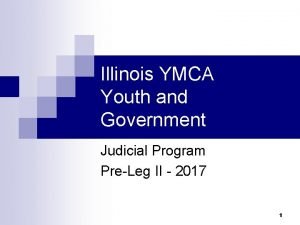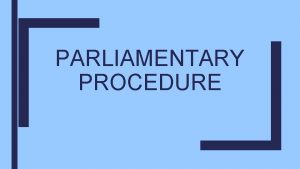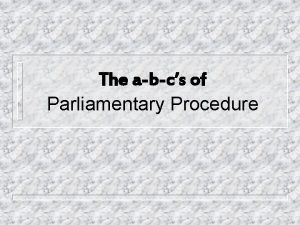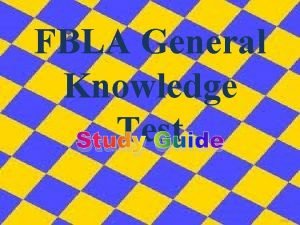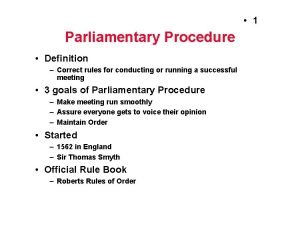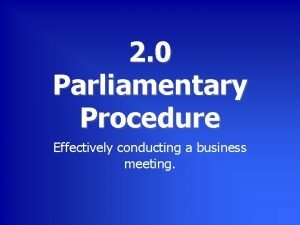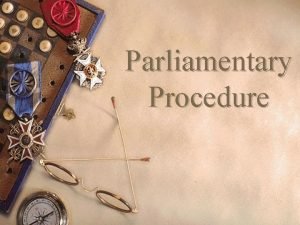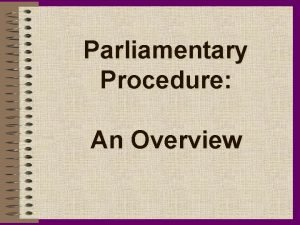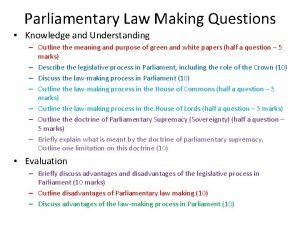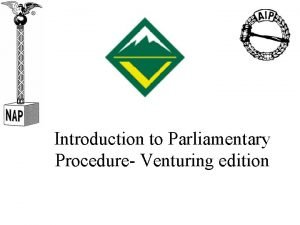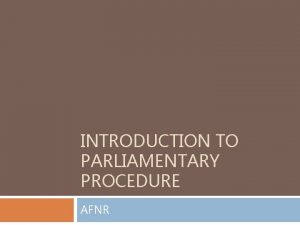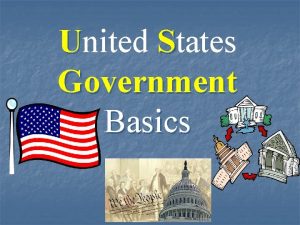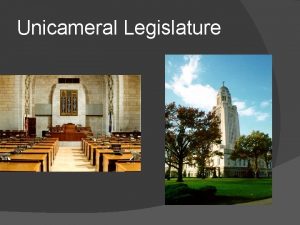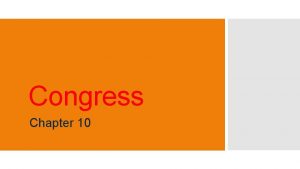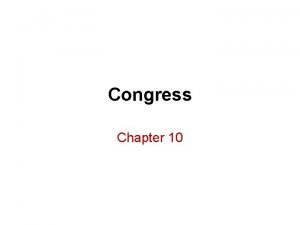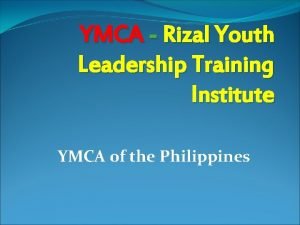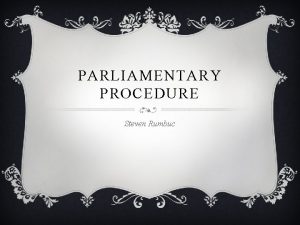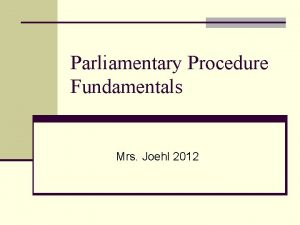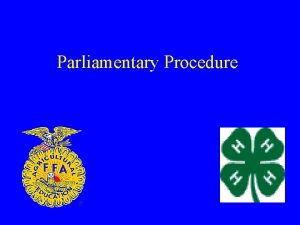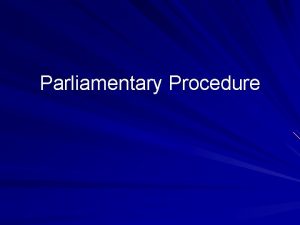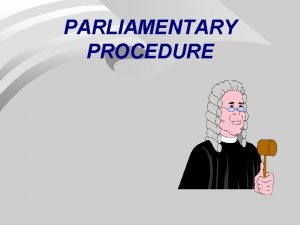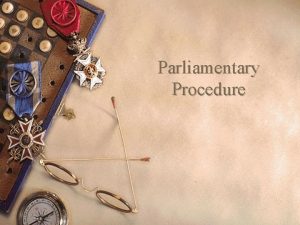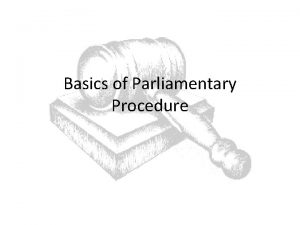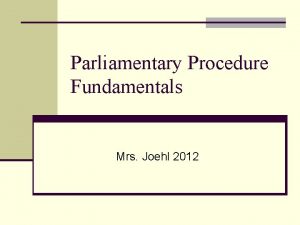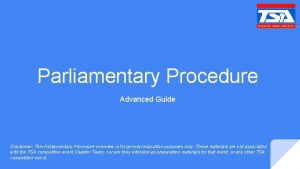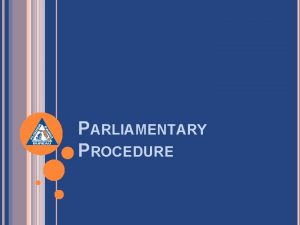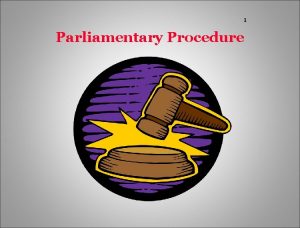YMCA Youth Legislature Parliamentary Procedure and Presenting a











![• You have two minutes to present your opening remarks. “[Last Name, City] • You have two minutes to present your opening remarks. “[Last Name, City]](https://slidetodoc.com/presentation_image_h2/087de164ac05bb845cbfa741f2782f82/image-12.jpg)









- Slides: 21

YMCA Youth Legislature Parliamentary Procedure and Presenting a Bill

OPENING THE SESSION

• The Presiding Officer (Lt. Governor in Senate, Speaker of the House in the House, First Year PO in First Year) will open the session. “The House is now called to Order. I will now call on the Senate chaplain for a morning devotion. ”

• Because, in the actual legislature, a bill must be heard 3 times on 3 separate days before it can be heard on the floor, the PO will then go through a process to open and close 3 mock days. This will allow us to debate. “Have we established quorum? ” *Quorum- the minimum number of members that must be present to make the proceedings valid. *

• Once the PO, Pro Tempore, and Floor Leader have finished the mock opening, the PO will open the floor up for the 1 st bill. “The First Item up for business is bill # ____. Will the patron of bill # ____ please come forward? ” *At YL, the first 3 bills will be predecided so that patrons have time to prepare. After that, the calendar, made by the rules committee, will go into effect. *

THE PRESENTATION OF A BILL

• Once the Patron has approached the lectern, the process of bill presentation begins. “The Patron now has 2 minutes for his opening remarks. ” • Once the patron is finished, the floor opens for debate. “The floor is now open for debate. [delegates raise placards] The chair recognizes Senator/Representative/Delegate ______” *DO NOT raise your placard before the floor is opened for debate. It’s bad decorum. ”

• Once debate ends on a bill (There a few ways this can happen. We’ll get to that later. ), the PO will call on the patron for his closing remarks. “ The patron now has two minutes for his closing remarks. ”

• Once the patron finishes his closing statement, the voting begins. “We will now move to voting on bill #___. Will the sergeant at arms please bar the door. All in favor please signify by saying ‘AYE. ’ [Ayes will Aye] All opposed ‘NAY. ’ [Nays will Nay] It is in the opinion of the chair that the ______ have it *RAP RAP* and they do. This bill does pass/fail. ” *It is NEVER EVER appropriate to clap when a bill fails. EVER. *

PRESENTING YOUR BILL

• When it is your turn to present your bill, the PO will call you up. We already went through that.
![You have two minutes to present your opening remarks Last Name City • You have two minutes to present your opening remarks. “[Last Name, City]](https://slidetodoc.com/presentation_image_h2/087de164ac05bb845cbfa741f2782f82/image-12.jpg)
• You have two minutes to present your opening remarks. “[Last Name, City] Thank you Sir/Madam Chair. * *Always address the PO as Sir or Madam Chair. It’s also courteous, but not required, to thank him. He didn’t HAVE to relinquish the floor to you. *

• To be recognized while your bill is the one being debated, simply raise your placard. You have precedence so the Presiding Officer will probably call on you. However, he does not HAVE to.

• Once debate on your bill is over, you’ll have two minutes for your closing remarks. You’ll introduce them in the same way as your opening.

• Whether your bill passes or fails, always ALWAYS be gracious. Huffing and puffing will not get the decision reversed, but it will leave a negative impression with the PO.

DEBATING A BILL

• To be recognized to speak on the floor, a delegate must raise his placard and be recognized by the chair. “The floor is once again open for debate. [Placards raised] The Chair recognizes Senator ____. ”

• Once you have introduced yourself, you can do 3 things: make a statement, ask questions, or ask questions and then make a statement. 1. “May I address my remarks to the chamber? ” 2. “Will the patron please yield to a possible series of questions? ” 3. “Will the patron please yield to a possible series of questions, and may I reserve my right to address the chamber thereafter? ”

• You can also reserve the right to yield time to another delegate. The important thing to remember is that you cannot make more than two motions. So you can’t ask questions, address the chamber, AND yield time. Only 2.

3 Ways Debate Can End • 1. ) There is no further debate “Seeing no further debate, we will now move to the Patron’s closing remarks. ” • 2. ) The floor leader moves to previous question. *This will require a vote. * • 3. ) Time for debate on the bill elapses. “Time for debate on this bill has elapsed. We will now move to the Patron’s closing remarks. ”

Previous Question • Only the floor leader can make motions. Previous question means debate will end and the chamber will move into voting. Previous question must pass by vote.
 Texas youth and government
Texas youth and government Illinois ymca youth and government
Illinois ymca youth and government Division of the house parliamentary procedure
Division of the house parliamentary procedure Hosa parliamentarian
Hosa parliamentarian Parliamentary procedure model un
Parliamentary procedure model un Abc's of parliamentry procedure
Abc's of parliamentry procedure The fbla-pbl national center is located where?
The fbla-pbl national center is located where? Parliamentary procedure definition
Parliamentary procedure definition Parliamentary procedure at a glance
Parliamentary procedure at a glance Parliamentary procedure hosa
Parliamentary procedure hosa Parliamentary procedure vocabulary
Parliamentary procedure vocabulary Postpone definitely ffa definition
Postpone definitely ffa definition History of parliamentary procedure
History of parliamentary procedure Parliamentary procedure outline
Parliamentary procedure outline Introduction to parliamentary procedure
Introduction to parliamentary procedure Introduction to parliamentary procedure
Introduction to parliamentary procedure Bicameral legislature
Bicameral legislature Unicameral legislature
Unicameral legislature Section 1 chapter 10 the national legislature
Section 1 chapter 10 the national legislature Unicameral vs bicameral legislature
Unicameral vs bicameral legislature The national legislature chapter 10
The national legislature chapter 10 Why does the constitution establish a bicameral legislature
Why does the constitution establish a bicameral legislature

